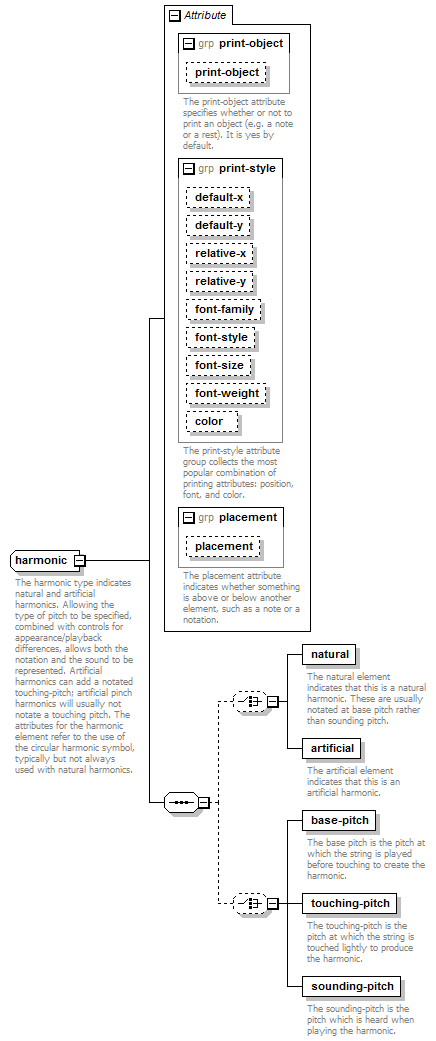harmonic
The harmonic type indicates natural and artificial harmonics. Allowing the type of pitch to be specified, combined with controls for appearance/playback differences, allows both the notation and the sound to be represented. Artificial harmonics can add a notated touching-pitch; artificial pinch harmonics will usually not notate a touching pitch. The attributes for the harmonic element refer to the use of the circular harmonic symbol, typically but not always used with natural harmonics. |
Complex Type Information
Model

Attributes
| QName | Type | Fixed | Default | Use | Inheritable | Annotation |
|---|---|---|---|---|---|---|
| color | color | optional | ||||
| default-x | tenths | optional | ||||
| default-y | tenths | optional | ||||
| font-family | comma-separated-text | optional | ||||
| font-size | font-size | optional | ||||
| font-style | font-style | optional | ||||
| font-weight | font-weight | optional | ||||
| placement | above-below | optional | ||||
| print-object | yes-no | optional | ||||
| relative-x | tenths | optional | ||||
| relative-y | tenths | optional |
Used By
| Element | technical/harmonic |
Source
<xs:complexType name="harmonic"> <xs:annotation> <xs:documentation>The harmonic type indicates natural and artificial harmonics. Allowing the type of pitch to be specified, combined with controls for appearance/playback differences, allows both the notation and the sound to be represented. Artificial harmonics can add a notated touching-pitch; artificial pinch harmonics will usually not notate a touching pitch. The attributes for the harmonic element refer to the use of the circular harmonic symbol, typically but not always used with natural harmonics.</xs:documentation> </xs:annotation> <xs:sequence> <xs:choice minOccurs="0"> <xs:element name="natural" type="empty"> <xs:annotation> <xs:documentation>The natural element indicates that this is a natural harmonic. These are usually notated at base pitch rather than sounding pitch.</xs:documentation> </xs:annotation> </xs:element> <xs:element name="artificial" type="empty"> <xs:annotation> <xs:documentation>The artificial element indicates that this is an artificial harmonic.</xs:documentation> </xs:annotation> </xs:element> </xs:choice> <xs:choice minOccurs="0"> <xs:element name="base-pitch" type="empty"> <xs:annotation> <xs:documentation>The base pitch is the pitch at which the string is played before touching to create the harmonic.</xs:documentation> </xs:annotation> </xs:element> <xs:element name="touching-pitch" type="empty"> <xs:annotation> <xs:documentation>The touching-pitch is the pitch at which the string is touched lightly to produce the harmonic.</xs:documentation> </xs:annotation> </xs:element> <xs:element name="sounding-pitch" type="empty"> <xs:annotation> <xs:documentation>The sounding-pitch is the pitch which is heard when playing the harmonic.</xs:documentation> </xs:annotation> </xs:element> </xs:choice> </xs:sequence> <xs:attributeGroup ref="print-object"/> <xs:attributeGroup ref="print-style"/> <xs:attributeGroup ref="placement"/> </xs:complexType> |